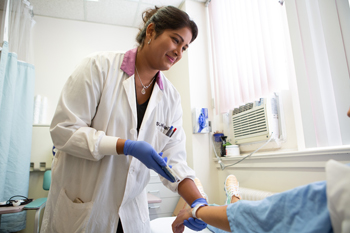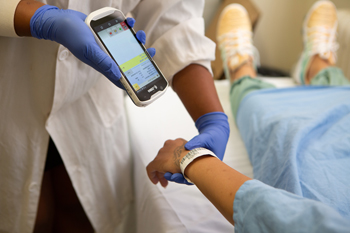Positive patient ID for phlebotomy: Improving safety when drawing blood

By Amber Daugherty

Leah Jaikaran demonstrates how positive patient ID works when drawing blood at the bedside. (Photos by Katie Cooper)
Leah Jaikaran doesn’t miss the laborious process of scanning through seemingly endless numbers of printed labels looking for the right match to go with a tube of blood that’s just been drawn.
A new system being introduced at St. Michael’s Hospital, called positive patient ID, is getting rave reviews for “how convenient and simple it is,” said the medical laboratory technician, who said it took the team a couple of days to get used to going electronic.
Health-care teams are constantly searching for new and effective ways to improve patient care – especially to find ways to make care safer. Phlebotomy, the process for drawing blood, is something that happens hundreds of times a day at a hospital like St. Michael’s and was identified as an area worth investing in improvement.
With the introduction of positive patient ID, medical laboratory technicians are now starting to carry mobile devices and portable printers. The device can scan a patient’s wristband to confirm the technician is drawing blood from the right person for the right test. The mobile device tells them what test is required, what tubes are needed and what time blood needs to be drawn.
The portable printer then spits out a label on the spot and all of the relevant information is digitally submitted in real time to the laboratory.
“We take patient safety very seriously,” said information technology coordinator Drake Yip. “Using positive patient ID adds an extra check to reduce the potential for mixing up patient samples. And it’s making the whole process quicker and more efficient.”

Another benefit of the system is that any urgent requests can be flagged on the technician’s mobile device – they flash on the screen and show up in red compared to the routine tests in black and timed tests in blue.
“The system updates every 30 seconds, which is especially helpful if someone needs a blood draw quickly – we see it immediately and can respond right away,” said Jaikaran.
The new system launched mid-June and is currently supporting technicians drawing blood at the bedside. The next step is to use the same process for blood transfusions, by scanning patients’ wristbands as well as the blood products they’re receiving to enhance patient safety.
“The laboratory is always looking at how we can increase patient safety and enhance overall quality,” said Dawn-Marie King, director of Laboratory Medicine and Diagnostic Imaging. “That includes looking at how we can bring in new technology – in this case, it’s a small change that’s making a huge difference for both our staff and our patients.”
About St. Michael’s Hospital
St. Michael’s Hospital provides compassionate care to all who enter its doors. The hospital also provides outstanding medical education to future health care professionals in more than 29 academic disciplines. Critical care and trauma, heart disease, neurosurgery, diabetes, cancer care, care of the homeless and global health are among the Hospital’s recognized areas of expertise. Through the Keenan Research Centre and the Li Ka Shing International Healthcare Education Centre, which make up the Li Ka Shing Knowledge Institute, research and education at St. Michael’s Hospital are recognized and make an impact around the world. Founded in 1892, the hospital is fully affiliated with the University of Toronto.
